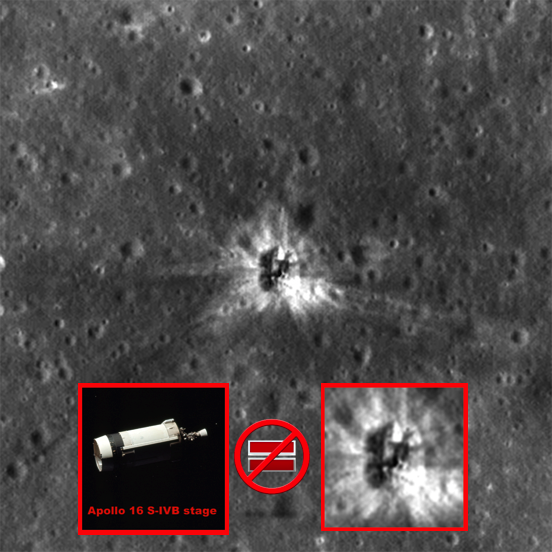Crashed UFO On Moon Not Apollo 16 Booster, UFO Expert Charges — Accuses NASA Of Cover Story
A NASA photo that purports to show the Apollo 16 booster rocket on the moon is claimed by some to be a UFO that crashed on the lunar surface, and NASA is allegedly covering up the startling discovery by claiming that the object is actually the 43-year-old Saturn V IVB booster used to propel the Apollo astronauts on their final approach to the moon on April 19, 1972 — three days after the massive Saturn V rocket blasted off from John F. Kennedy Space Center in Merritt Island, Florida.
Starting with the Apollo 13 moon mission, NASA deliberately sent the booster rockets hurtling straight toward the lunar surface, in what was intended as an attempt to measure the seismic reaction created by the inevitable crashes.
But while NASA had earlier found exactly where the booster rockets from Apollo missions 13, 14, 15 and 17 made impact with the surface of the moon, the site where the Apollo 16 booster hit the surface had remained a mystery for more than four decades since the next-last-manned moon mission made its successful journey.
A short documentary detailing the NASA story of the Apollo 16 mission may be viewed in the video below.
“After decades of uncertainty, the Apollo 16 S-IVB impact site on the lunar surface has been identified,” wrote NASA in a press release on December 3. “The site was identified in imagery from the high-resolution LROC Narrow Angle Camera aboard NASA’s Lunar Reconnaissance Orbiter.”
The booster, before it crashed, would have appeared nearly identical to the Saturn booster pictured below from the Apollo 17 mission in December of 1972.


“There is no way that this object on Earth’s moon is the old Apollo 16 booster rocket. The size might be similar, but its shape is totally wrong,” the Taiwan-based Waring wrote on his blog early Friday local time.
“This object is more similar to an ocean ship than a cylinder of a rocket. It’s defiantly (sic) the crashed wreckage of an alien ship. I think NASA wants to claim it so that other countries will respond with a hands off, since it’s ‘US govt property.’ I don’t think the Chinese will fall for that fake out,” the prominent UFO researcher wrote.
Waring also says that the object in the photo is considerably larger than the booster rocket.
“NASA states that the photo is 400 meters across, then the object here is 33.3 meters long. So that confirms its not the booster rocket, which is only 17.8 meters long by 6.6 wide. This crashed UFO is 2X bigger than the booster rocket,” Waring states.
RELATED STORIES: Alien City On Moon Seen In NASA Photo — Here's How You Can Find It For Yourself 'Triangle UFO' Seen In NASA Apollo 17 Moon Landing Photo Same Object In Lunar Module Film? NASA Moon Photo Reveals UFO 'Camouflaged' As Breakaway Chunk Of Lunar Surface, UFOlogist Says UFO Spotted In Apollo 15 NASA Moon Mission Photo From 44 Years Ago — Apollo 12 Also
A statement on the LRO Camera site says that NASA identified the booster by the distinctive pattern of the crater created on impact.
“The high and low reflectance rays extending out far from the rim are distinctive of the S-IVB impact craters and allow confident identification,” the LROC site stated.
But Waring remained unconvinced, even posting his own image contrasting the appearance of the booster rocket with the object seen in the lunar impact crater.

The Apollo 16 mission was commanded by astronaut John W. Young, who was 41 years old at the time and can be seen on the lunar surface in the NASA photo at the top of this page.
Jeff Plescia of The Johns Hopkins University Applied Physics Laboratory in Laurel, Maryland, was the scientist who finally identified the crashed booster rocket — or according to Waring, the wreckage of an alien UFO — in the high-resolution NASA LRO photo.
[Featured Photo By Charles M. Duke Jr. / NASA]









